Capital-efficient investors now have a plethora of different toppings to stack atop their towering banana split sundae.
Stocks. Check.
Bonds. Yup.
Managed Futures Trend. Roger, that.
Gold. Indeed.
And now Carry.
More specifically, a multi-asset futures yield carry strategy.
RSSY ETF is the latest offering from the Return Stacked crew.
It’s better known as Return Stacked US Stocks & Futures Yield ETF.
It’s another potential ‘return stacking‘ building block that can be used to assemble the capital-efficient portfolio of your dreams.
To learn more about this fund, let’s turn things over to its creator Corey Hoffstein.

Meet Corey Hoffstein – CEO & CIO Newfound Research
Corey Hoffstein is the CEO and CIO of Newfound Research, where he is responsible for overseeing the Newfound’s investment team and the ongoing management of Newfound’s investment strategies.
Corey is an active researcher and his work has been published in the Journal of Indexing and the Journal of Alternative Investments. He is also the host of the popular quantitative investing podcast Flirting with Models.
Corey holds a Master of Science in Computational Finance from Carnegie Mellon University and a Bachelor of Science in Computer Science, cum laude, from Cornell University.
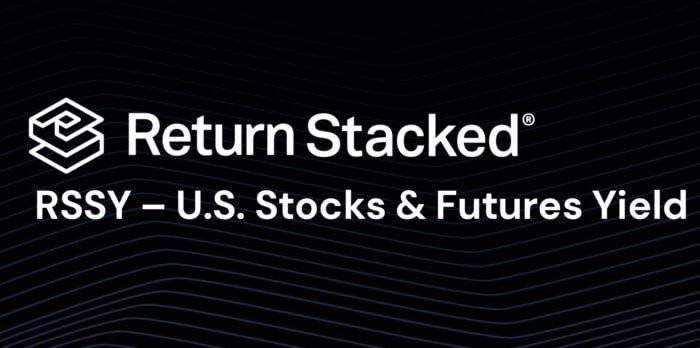
Reviewing The Strategy Behind RSSY ETF (Return Stacked US Stocks & Futures Yield ETF)
Hey guys! Here is the part where I mention I’m a travel content creator! This “The Strategy Behind The Fund” interview is entirely for entertainment purposes only. There could be considerable errors in the data I gathered. This is not financial advice. Do your own due diligence and research. Consult with a financial advisor.

These asset allocation ideas and model portfolios presented herein are purely for entertainment purposes only. This is NOT investment advice. These models are hypothetical and are intended to provide general information about potential ways to organize a portfolio based on theoretical scenarios and assumptions. They do not take into account the investment objectives, financial situation/goals, risk tolerance and/or specific needs of any particular individual.
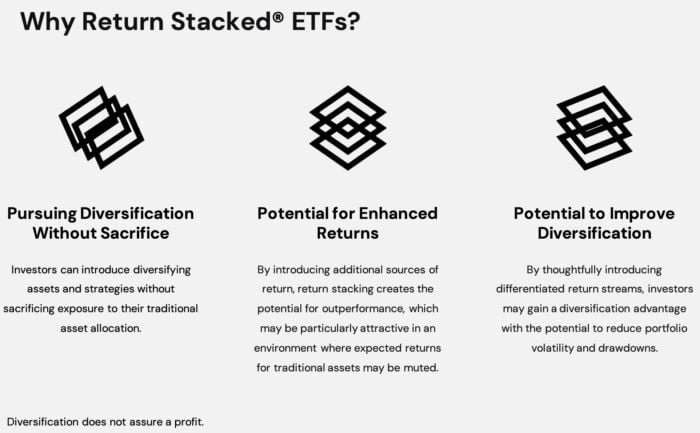
What’s The Strategy Of RSSY ETF?
For those who aren’t necessarily familiar with a “Return Stacked capital efficient” style of asset allocation, let’s first define what it is and then explain this strategy in practice by giving some clear examples.
Most investors will acknowledge that more diversification is generally favorable to less. By combining uncorrelated assets, wealth can compound more consistently and investors can achieve their financial plans with more certainty.
The best non-correlated options tend to be alternative assets like gold and commodities as well as alternative strategies like managed futures trend following, systematic global macro and other liquid alternatives. Unfortunately, most investors today allocate little to no money to these areas. Why?
In my experience, it is because adding alternatives also means subtracting exposure to core stocks and bonds. This can create significant tracking error and lead to substantial relative underperformance during decades like the 2010s when stocks and bonds thrived and many alternatives languished.
Return stacking aims to solve this problem by providing investors with a “yes and” solution rather than an “either/or” decision.
It does this by combining multiple exposures into a single fund. For example, in the Return Stacked® U.S. Stocks & Futures Yield ETF (RSSY), for every $1 invested, we provide $1 of exposure to large-cap U.S. equities and $1 of exposure to a futures yield (carry) strategy.
By swapping out a portion of core stock exposure with RSSY, we are able to reintroduce the core exposure AND stack a futures yield (carry) strategy on top of the original portfolio.
For more on return stacking, you can visit our “what is return stacking” primer.
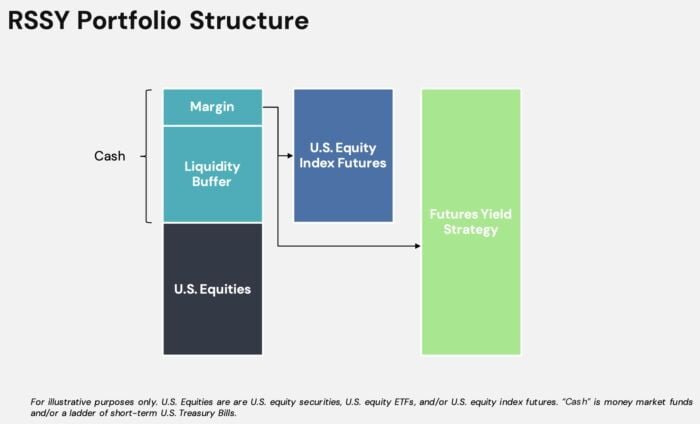
Unique Features Of Return Stacked US Stocks & Futures Yield Fund RSSY ETF
Let’s go over all the unique features your fund offers so investors can better understand it. What key exposure does it offer? Is it static or dynamic in nature? Is it active or passive? Is it leveraged or not? Is it a rules-based strategy or does it involve some discretionary inputs? How about its fee structure?
For every $1 invested, the Return Stacked® U.S. Stocks & Futures Yield ETF (RSSY) is designed to provide $1 of large-cap U.S. equity exposure and $1 of exposure to a futures yield (carry) strategy.
The relative exposure to U.S. equities and the futures yield strategy is static.
The large-cap U.S. equity exposure simply seeks to provide broad large-cap U.S. equity exposure (e.g. S&P 500); there is no active stock-picking component.
The futures yield strategy seeks to provide long and short exposure across commodities, currencies, bonds, and equities via futures contracts using a systematic and quantitative process that seeks to harvest roll yield (carry) in futures contracts.
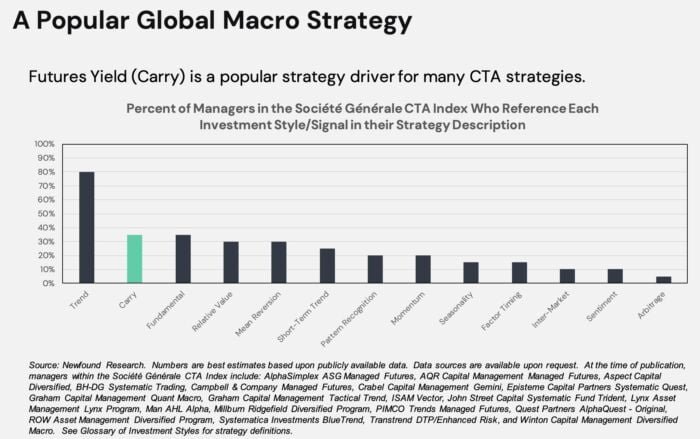
What Sets RSSY ETF Apart From Other Funds?
How does your fund set itself apart from other “asset allocation” funds being offered in the marketplace? What makes it unique?
There are two primary differentiators to this fund.
- We believe return stacking is the key value proposition. There are hundreds of U.S. equity funds and dozens of systematic futures funds. We’re not aware of any that give you $1 of exposure to U.S. equities and $1 of futures yield (carry) for every $1 invested.
This enables a whole new dimension of portfolio construction for investors and allocators. - We are not aware of any multi-asset carry strategies currently available in either a mutual fund or ETF wrapper today. We believe this introduces an important, novel exposure for investors.

What Else Was Considered For RSSY ETF?
What’s something that you carefully considered adding to your fund that ultimately didn’t make it past the chopping board? What made you decide not to include it?
Since the primary thesis behind the returns of futures yield (carry) strategies is risk based, we were concerned that the strategy would exhibit too much correlation to stocks and bonds. Based on this concern, we discussed the idea of running a strategy that significantly constrained stock and bond beta.
Empirically, however, we found that our concerns were unfounded. While an unconstrained implementation does exhibit significant time-varying correlation to stocks and bonds, it appears unconditional as to whether stocks or bonds are performing well or poorly.
As constraining the solution meaningfully hurt returns and did not appear to meaningfully improve risk during any adverse stock or bond scenarios, we elected to implement an unconstrained strategy.
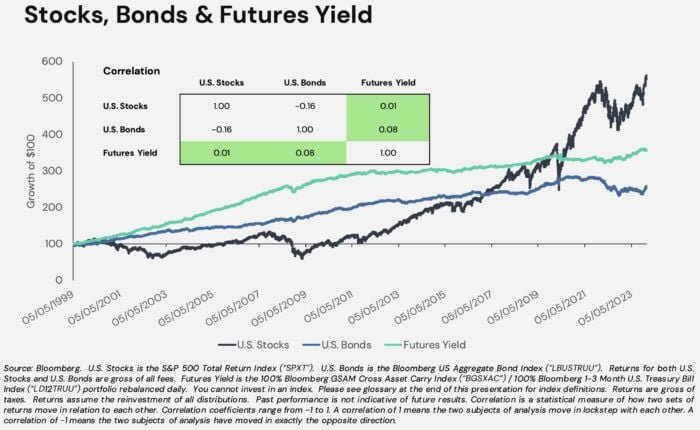
When Will RSSY ETF Perform At Its Best/Worst?
Let’s explore when your fund/strategy has performed at its best and worst historically or theoretically in backtests. What types of market conditions or other scenarios are most favourable for this particular strategy? On the other hand, when can investors expect this strategy to potentially struggle?
The fund is new and I cannot discuss backtests. That said, we like the “return stacking” nomenclature because we think it helps explain precisely how returns in the fund should materialize.
While U.S. equities and futures yield (carry) have exhibited a low degree of correlation historically, they have exhibited high degrees of correlation over short-term periods. These periods can lead to amplified returns: both positive and negative.
We’d expect the fund to do well during periods when U.S. equities are doing well and futures yield (carry) is doing well, and we’d expect the fund to do poorly when U.S. equities are doing poorly and futures yield (carry) is doing poorly.
Unfortunately, specifying when we would expect futures yield (carry) to do well or poorly is not straight forward. Empirically, we find that diversified futures yield (carry) strategies exhibit little sensitivity to the returns of stocks and bonds and little sensitivity to any particular growth or inflation-based macro-economic regime.
On average, we’d expect the volatility of U.S. equities to match well with the volatility of the futures yield (carry) strategy, so neither should dominate the ETF’s risk profile over the long run.
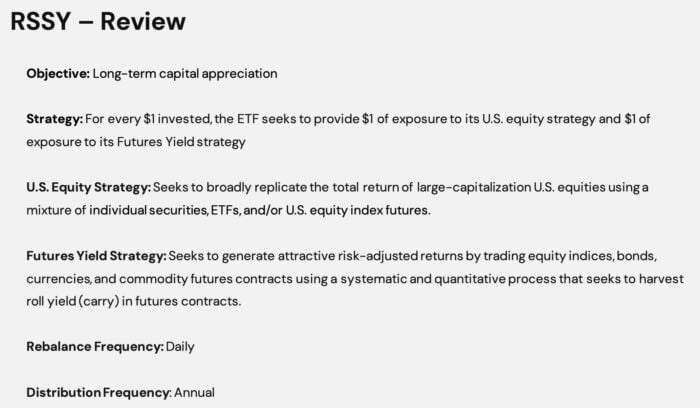
Why Should Investors Consider Return Stacked US Stocks & Futures Yield Fund RSSY ETF?
If we’re assuming that an industry standard portfolio for most investors is one aligned towards low cost beta exposure to global equities and bonds, why should investors consider your fund/strategy?
Our aim with Return Stacked funds is to allow investors to keep their global beta exposure and complement it with diversifying alternatives.
Why should they replace that low-cost exposure with a more expensive fund?
- By retaining the core beta through stacking, the fee is explicitly to pay for the alternative. We no longer have to ask, “can the alternative outperform the core beta after fees,” but simply: “can the alternative outperform the fees?”
- We believe we can offer the alternatives at a lower cost than our peer group.
- We believe that introducing additional return streams through stacking has several potential benefits, including: (1) enhanced long-term returns; (2) the potential to improve diversification and reduce risk; and (3) the potential for a more sustainable allocation to alternatives.

How Does RSSY ETF Fit Into A Portfolio At Large?
Let’s examine how your fund/strategy integrates into a portfolio at large. Is it meant to be a total portfolio solution, core holding or satellite diversifier? What are some best case usage scenarios ranging from high to low conviction allocations?
The primary use case for RSSY is quite simple: replacing large-cap U.S. equities with RSSY allows investors to retain their large-cap U.S. equity exposure while introducing a futures yield (carry) strategy to their portfolio.
The size of the allocation ultimately determines the size of the overlay. I believe you’ve introduced this to your audience as “what is the canvas size” of the portfolio. For example, selling 5% of large-cap U.S. equity exposure to buy RSSY would create a 5% futures yield (carry) overlay on the portfolio, a total canvas size of 105%; selling 20% to buy RSSY would result in a 20% overlay, a total canvas size of 120%.

The Cons of RSSY ETF
What’s the biggest point of constructive criticism you’ve received about your fund since it has launched?
Many investors are simply averse to leverage. And, make no mistake, return stacking is an application of leverage.
The fear of leverage is understandable: if you look at just about every major financial catastrophe, you’ll find leverage lurking at the crime scene. But it is usually concentrated leverage.
What we’re specifically advocating for is utilizing leverage to better unlock the potential benefits of diversification. We believe that return stacking can not only help investors introduce alternatives in a way that can improve expected portfolio results, but also introduce alternatives in a manner that is behaviorally sustainable.

The Pros of RSSY ETF
On the other hand, what have others praised about your fund?
We are excited at the number of people who see our funds the same way we do: pre-stacked building blocks that enable a variety of different portfolios to be constructed.
Some may elect to create a small overlay on their very traditional stock-bond portfolio. Others have created examples where they re-think what an “all weather” portfolio might look like, creating levered, balanced allocations of stocks, bonds, commodities, and alternative strategies.
Our intention with launching Return Stacked ETFs (www.returnstackedetfs.com) is not to be prescriptive (though we do have opinions), but rather to provide the building blocks for informed investors to build the portfolios that are best for them. Having said that, we do offer clear assembly instructions via model portfolios for those advisors and institutions that want turnkey solutions and incorporate other pre-packaged funds and ETFs at Return Stacked Portfolio Solutions (www.returnstacked.com).
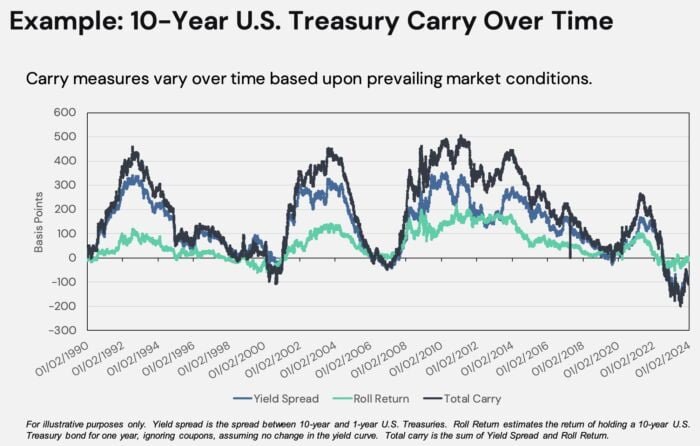
Examples Of Successful Carry Trades
For investors not familiar with this particular alternative strategy can you provide some hypothetical examples of successful carry trades?
When investors think of a positive return, they usually think about selling something for more than they bought it. This framework, however, ignores a second, important source of return. Landlords, for example, can earn a return from both the price appreciation of their property as well as rental income.
This second source of return is called “carry” and can be loosely defined as the expected return of an investment assuming no change in its price. Investing for dividend yield or selling options for income are two ways of investing for carry.
As a measure, carry exists across stocks, bonds, commodities, and currencies. A diversified carry strategy will go long and short in different markets seeking to maximize exposure to this driver of returns.
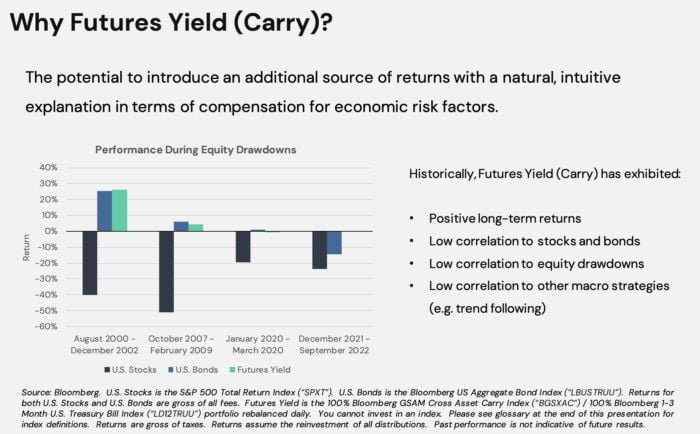
How Does Carry Combine With Other Alternative Strategies?
How does adding a carry strategy to your portfolio combine with another alternative strategy such as trend following? Is there an optimal mix for investors to potentially consider?
The simple math answer here is, “in isolation, when you have two things with approximately the same expected returns and volatilities, you’d equally-weight them.”
“In isolation” is doing quite a bit of heavy lifting in that sentence, however. In reality, most investors start with a stock-bond portfolio. We find, empirically, that diversified carry strategies, on average over time, have a low correlation to stocks and bonds, making them an attractive additional source of returns for traditionally allocated portfolios.
Diversified carry strategies also exhibit low correlation to trend following strategies. This feature is at least partially mechanical, particularly in extremes. For example, while trend following may chase equity prices upward in a strong trend, carry strategies may simultaneously begin to short equities at the same time, as increasing prices will decrease expected dividend yield (a measure of carry in equities), making them relatively less attractive.
Taken together, a naïve, equally weighted combination of both carry and trend following creates a difficult hurdle for any optimized blend to overcome.
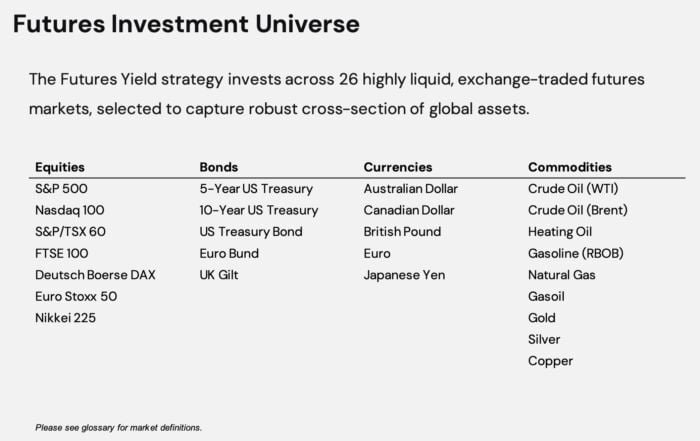
Diversification Benefits Of Carry Strategies
What are the potential diversification benefits of including carry exposure in a multi-asset portfolio?
Before evaluating empirical data, there are two important points to consider with a multi-asset carry strategy. First, for traditional stock-bond investors, multi-asset carry strategies will introduce exposure to commodities and currencies that they may not otherwise hold.
Second, multi-asset carry strategies will take both long and short positions, seeking to maximize carry exposure. In doing so, they will only hold equity or bond beta when they provide attractive relative carry compensation versus other opportunities.
Taken together, we would expect multi-asset carry strategies to exhibit little correlation to traditional portfolio holdings on average. Empirically, that is precisely what we find. Importantly, and contrary to popular beliefs about carry, we also find that they exhibit little conditional correlation, historically performing no better or worse in the best and worst performing periods for stocks and bonds.
It should be stressed, however, that average zero correlation is not negative correlation. In other words, empirical data suggests that carry is just as likely to lose money as it is to make money when equity or bond indices come under stress. Furthermore, zero on average is not always zero, and it is possible for carry strategies to have very high correlations to both stocks and bonds, which can coincide with sudden market shocks in both directions. Conversely, it is possible for carry strategies to have very strong negative correlations to both stocks and bonds which would act as a counterweight to market shocks in both directions.
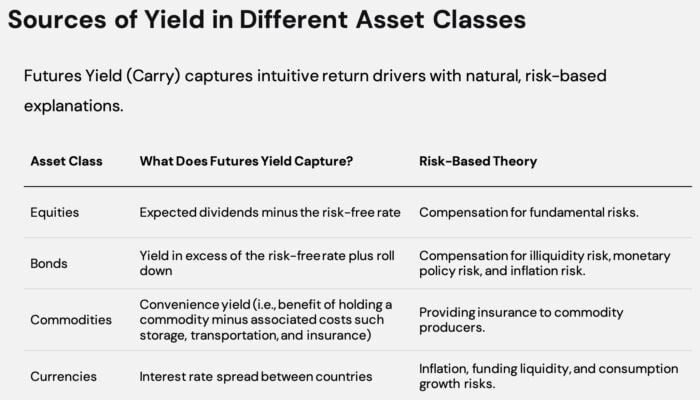
Multi-Asset Carry Strategy Benefits
What are some of the potential competitive advantages of your carry strategy (multi-asset class) compared to others (limited to say just currencies)?
Like most strategies, we believe that carry benefits from diversification.
In isolation, carry strategies (both cross-sectional and time-series) within equities, bonds, commodities, and currencies have all exhibited positive excess returns. Nevertheless, we believe an isolated approach sacrifices valuable cross-sector information, both in identifying the most attractive relative carry opportunities as well as the ability to manage risk.
For example, a more limited approach may simply go long high carry currencies and short low carry currencies. An optimized, multi-asset approach, however, may find that the opportunity in high carry currencies is more effectively hedged with short commodity or bond exposure.
We believe that taking a multi-asset, portfolio-based approach allows us to better maximize carry exposure on a risk-adjusted basis.
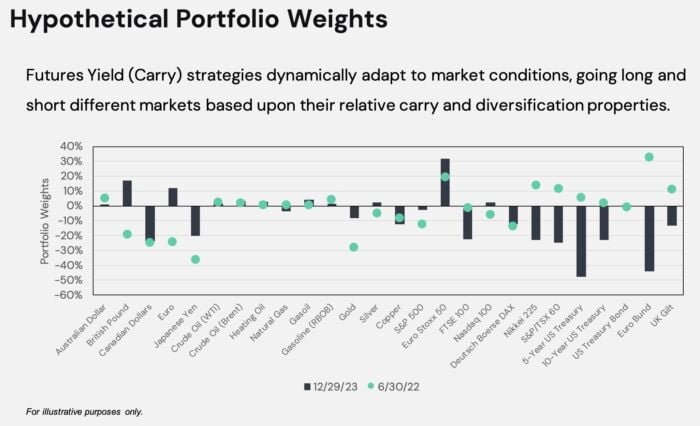
Managing Carry Risk
What historical precedents shape your approach to managing carry risk?
When people think about the “carry trade,” they often think of currency, and more specifically, the yen carry trade. For years heading into 2008, the yen was a popular funding currency because it was possible to borrow at exceedingly cheap interest rates in Japan. The classic currency trade would be to convert the yen into a basket of higher yielding currencies, allowing traders to capture the spread in interest rates. More creative financial engineers took this trade one step further and simply used the yen as a general funding source for any trade.
That trade, however, was a spectacular example of what can go wrong when high concentration (specifically, exposure to the yen) and leverage are mixed. The 2008 crisis sparked a procyclical unwind, driving the yen higher and wiping out years of carry capture.
Even in a multi-asset carry portfolio, it’s likely that the yen would have been identified as an attractive source of carry funding. Portfolio-level design, however, can help dramatically reduce the risk of a single carry trade having undue influence on portfolio returns.
- Portfolio optimization. By seeking to maximize carry per unit of risk, an optimized portfolio will favor more diversification over less, all else held equal.
- Position and sector-level position caps. Prudent limits are applied at both the position level and the sector level to provide guard rails to the optimization process.
- Portfolio-level volatility targets. By targeting a constant volatility level, the portfolio will naturally cut gross leverage as volatility increases, which is likely to happen in a more concentrated positioning.
Portfolio-level risk limits. As an ETF, the strategy must adhere to the SEC’s 18f-4 derivatives rule, which specifies VaR-based targets (i.e. worst-case loss estimates) the portfolio must adhere to, limiting gross leverage particularly when positions are more concentrated.
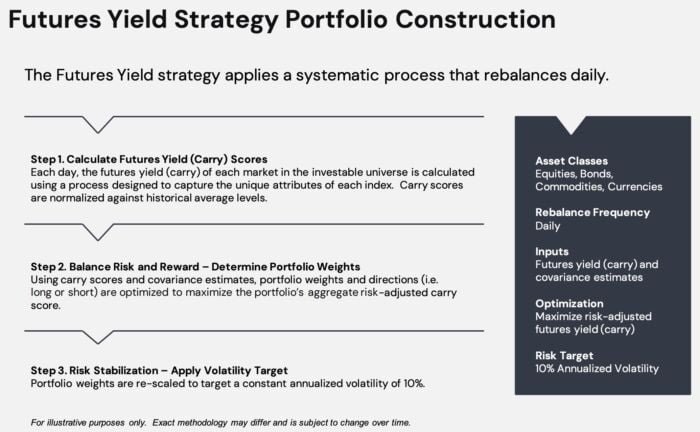
Carry As A Single Strategy Stack vs Style Premia Stack
Why did you choose “carry” as a single strategy to stack compared to other style premia (whether multi-strategy or not) such as “defensive” or “relative value” or “momentum” or “seasonality”?
We believe carry offers several very attractive features.
First, empirically, it has had very low correlation to stocks, bonds, and trend following strategies. This makes it a natural complement not only to traditionally allocated portfolios but also our existing strategy lineup.
Second, the primary thesis for why carry strategies offer returns is risk based, a distinct difference to trend following which is historically argued to be a largely behavioral phenomenon. We believe this provides a strong basis for why carry should continue to be uncorrelated.
Finally, we also believe that carry strategies can be implemented at significant scale and reasonable turnover, which is an important consideration when managing an ETF.
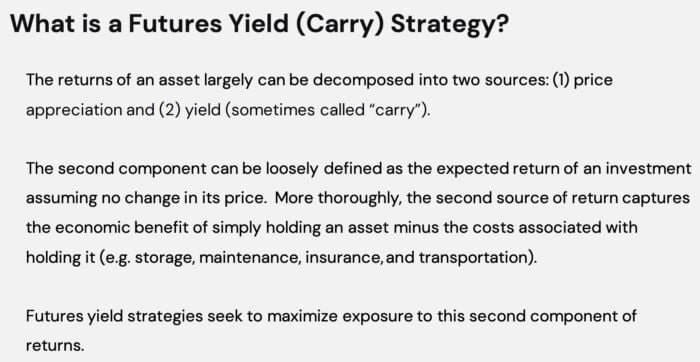
Absolute Return Potential Of Multi-Asset Carry Strategy
What’s the absolute return potential in various market regimes of a multi-asset carry strategy?
Empirical evidence suggests that carry is not highly regime dependent, either in its sensitivity to traditional assets (e.g. stocks and bonds) or economic periods (e.g. growth and inflation).
We believe that, after transaction and management costs, a reasonable long-term Sharpe ratio expectation for an optimized carry strategy is 0.3-0.4, implying a 3-4% expected excess return (returns above cash) for a strategy targeting 10% annualized volatility.
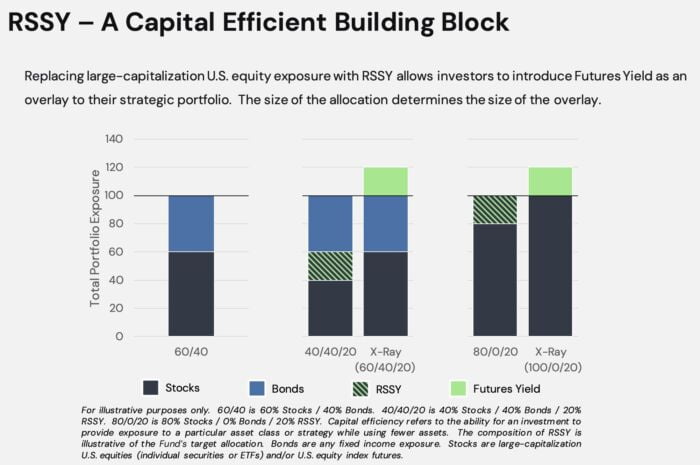
Learn More About RSSY ETF
We’ll finish things off with an open-ended question. Is there anything that we haven’t covered yet that you’d like to mention about your fund/strategy? If not, what are some other current projects that you’re working on that investors can follow in the coming weeks/months?
As I mentioned in the last answer, we see our funds as pre-stacked building block solutions and so, as you might expect, we plan to continue to launch different combinations of stacks in the coming months and years.
For financial professionals, we also offer model portfolios. These are turnkey portfolio solutions that implement return stacking concepts and are available in a variety of risk profiles. Advisors can implement them directly, customize them, or simply use them as inspiration. We plan on expanding our model lineup over the next several years.
We’ve also been working on several tools to allow investors to learn by getting their hands dirty. To date we’ve published two tools: the Return Stacking Visualizer and a Return Stacking Withdrawal Visualizer. The former allows investors to easily explore and backtest different return stacking concepts. The latter allows investors to explore how return stacking combinations can impact portfolio longevity and withdrawals. Both are currently available to financial professionals after they register on our website. We hope to expand this toolkit going forward.
Finally, we recognize that this concept will be novel for many, so education is a strong focus for us. So, we plan on publishing more content on our blog as well as our YouTube channel.

Connect With Corey Hoffstein & Return Stacked Portfolio Solutions
X/Twitter: X.com/@choffstein / X.com/@returnstacked
YouTube: Youtube.com/@ReturnStacked
Website: ReturnStacked.com / ReturnStackedETFs.com

Nomadic Samuel Final Thoughts
I want to personally thank Corey Hoffstein for taking the time to participate in “The Strategy Behind The Fund” series by contributing thoughtful answers to all of the questions!
The screen captures used in the article are from a presentation pdf that is well worth checking out to learn more about the fund: https://www.returnstackedetfs.com/wp-content/uploads/2024/05/RSSY-Presentation.pdf
Check out interviews related to other Return Stacked Funds: RSST, RSSB & RSBT
If you’ve read this article and would like to have your fund featured, feel free to reach out to nomadicsamuel at gmail dot com.
That’s all I’ve got!
Ciao for now!
Important Information
Comprehensive Investment Disclaimer:
All content provided on this website (including but not limited to portfolio ideas, fund analyses, investment strategies, commentary on market conditions, and discussions regarding leverage) is strictly for educational, informational, and illustrative purposes only. The information does not constitute financial, investment, tax, accounting, or legal advice. Opinions, strategies, and ideas presented herein represent personal perspectives, are based on independent research and publicly available information, and do not necessarily reflect the views or official positions of any third-party organizations, institutions, or affiliates.
Investing in financial markets inherently carries substantial risks, including but not limited to market volatility, economic uncertainties, geopolitical developments, and liquidity risks. You must be fully aware that there is always the potential for partial or total loss of your principal investment. Additionally, the use of leverage or leveraged financial products significantly increases risk exposure by amplifying both potential gains and potential losses, and thus is not appropriate or advisable for all investors. Using leverage may result in losing more than your initial invested capital, incurring margin calls, experiencing substantial interest costs, or suffering severe financial distress.
Past performance indicators, including historical data, backtesting results, and hypothetical scenarios, should never be viewed as guarantees or reliable predictions of future performance. Any examples provided are purely hypothetical and intended only for illustration purposes. Performance benchmarks, such as market indexes mentioned on this site, are theoretical and are not directly investable. While diligent efforts are made to provide accurate and current information, “Picture Perfect Portfolios” does not warrant, represent, or guarantee the accuracy, completeness, or timeliness of any information provided. Errors, inaccuracies, or outdated information may exist.
Users of this website are strongly encouraged to independently verify all information, conduct comprehensive research and due diligence, and engage with qualified financial, investment, tax, or legal professionals before making any investment or financial decisions. The responsibility for making informed investment decisions rests entirely with the individual. “Picture Perfect Portfolios” explicitly disclaims all liability for any direct, indirect, incidental, special, consequential, or other losses or damages incurred, financial or otherwise, arising out of reliance upon, or use of, any content or information presented on this website.
By accessing, reading, and utilizing the content on this website, you expressly acknowledge, understand, accept, and agree to abide by these terms and conditions. Please consult the full and detailed disclaimer available elsewhere on this website for further clarification and additional important disclosures. Read the complete disclaimer here.




